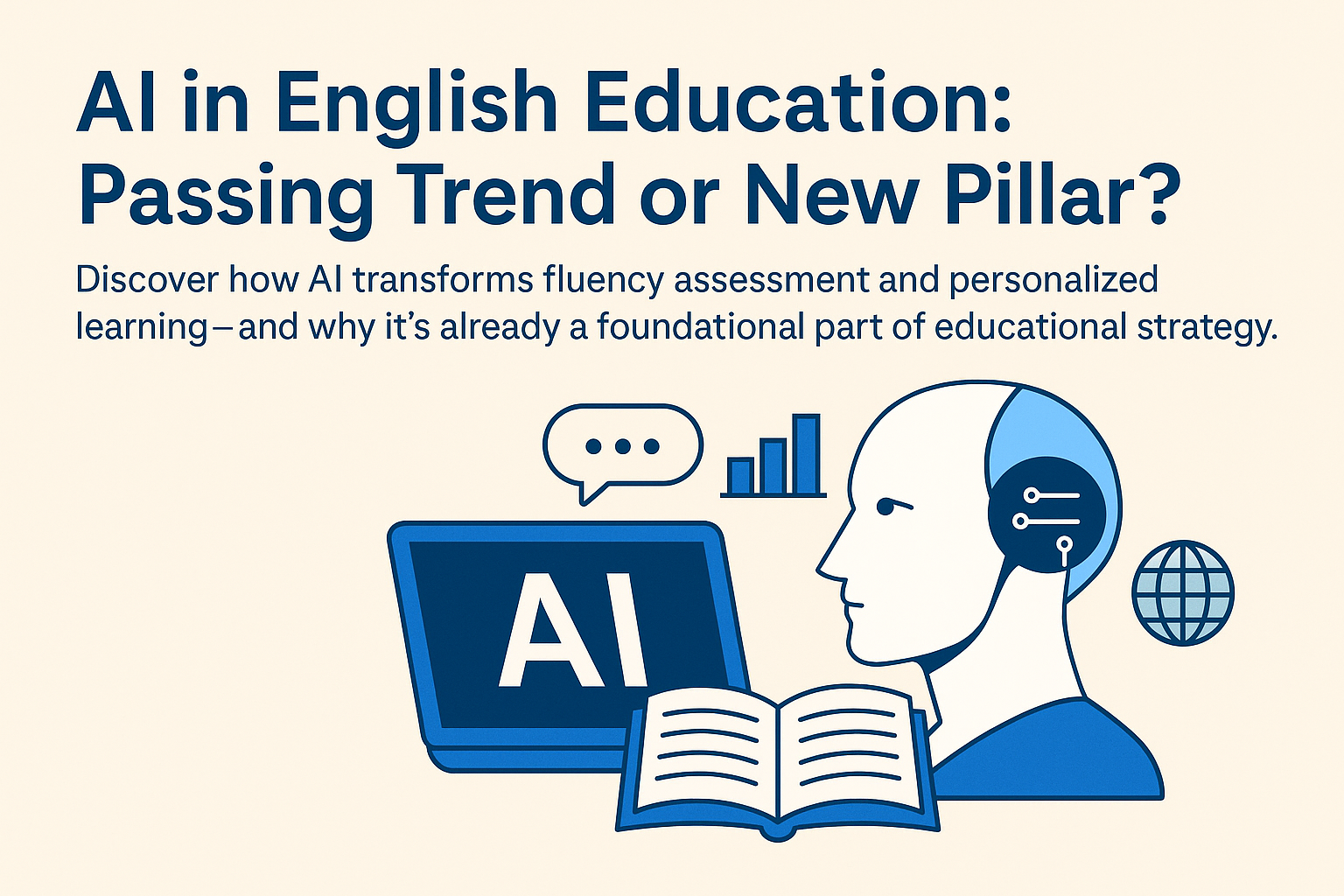Discover how AI transforms fluency assessment and personalized learning—and why it’s already a foundational part of educational strategy.
Artificial intelligence has arrived in English education with full force. AI-powered tools are already used to grade assignments, recommend content, and offer instant feedback to students and teachers.
But in the field of language learning, the discussion goes even further:
Are we looking at a temporary supplement or a new pillar in English education?
This question is no longer theoretical. Schools and institutions worldwide are pressured to deliver measurable outcomes, personalize learning journeys, and prepare students for a world where confident spoken English is no longer a nice-to-have but a basic requirement.
In this article, we’ll explore why AI in English education is shifting from trend to infrastructure, how it’s being applied across educational contexts, and what institutions should consider when adopting it.
What You’ll Learn in This Article:
What Does AI Offer in English Education?
The term “AI” may sound complex, but its use in education is more practical than many realize. In English language learning, for example, AI-powered tools can now:
- Analyze student voice recordings to identify speaking challenges
- Deliver personalized feedback based on real oral performance
- Recommend content tailored to individual needs
- Track student progress across entire classes using objective data
- Assess fluency at scale—consistently and without human bias
What used to require time-consuming interviews and subjective scoring can now be done more frequently, efficiently, and accurately. AI enables what schools have long sought: personalization with scalability.
Applications Across Different Education Levels
AI in English teaching can be implemented in various ways depending on context and audience.
- In primary and secondary education, it helps monitor speaking development early on, identifying key learning gaps.
- AI supports tracking language progression in higher education, especially for elective courses and exchange programs.
- It enables fluency assessments at a volume and with instant results in language institutes and private courses, which is crucial for schools with high student turnover or multiple locations.
- For educational networks, it brings the added value of standardized data across schools, cities, or regions, while requiring less operational effort. One example is Duolingo, which has successfully scaled AI-driven language personalization, fueling massive user growth worldwide.
What Role Do Teachers Play in This Tech Revolution?
Contrary to popular belief, AI doesn’t replace English teachers—it empowers them.
Teachers can access automated reports with detailed insights instead of manually grading dozens of speaking tests. This frees up time to do what matters: tailor instruction, observe more nuanced aspects of communication, and deepen learning experiences.
AI can also support continuous teacher development. With real student data, educators can adjust teaching strategies based on what’s working and what’s not.
Impact on Institutional Performance Indicators
One of the most significant benefits of AI in English teaching is its impact on institutional performance tracking.
By automating oral fluency assessments, schools can demonstrate the effectiveness of their teaching strategies using real, precise, data-backed results.
- Families and school owners gain visibility into student progress
- Pedagogical teams make better curriculum decisions
- Marketing teams gain concrete differentiators to promote the institution
AI also brings consistency to assessments, which is critical for networks with multiple schools, age groups, and educational contexts.
Global Trends: Why Fluency Is Taking the Spotlight
Worldwide, the focus is shifting from “English level” to “real language use.”
Fluency, clarity, spontaneity, and adaptability are increasingly valued over grammatical accuracy.
In this new landscape, AI becomes essential for measuring communication skills. Speaking ability has moved to the center of language education, whether for academic progress, institutional reports, or job market readiness.
When speaking must be assessed at scale—something manual methods can’t sustain—technology goes from being helpful to indispensable. Major players like Google are investing heavily in AI-powered personalized language learning, confirming this shift.
Ethical and Pedagogical Considerations
As with all edtech, AI must be used responsibly.
That means:
- Protecting student data privacy
- Avoiding cultural bias in scoring algorithms
- Keeping teachers at the core of the learning experience
Institutions should choose AI tools that are transparent, based on recognized linguistic criteria, and positioned as support, not replacements, for educators.
The quality of analysis, the clarity of feedback, and the alignment with pedagogical goals are critical for ethical and practical adoption.
Conclusion
The debate is no longer about whether AI will transform language education—it already is.
The real question now is: how will your institution adapt?
Integrating AI into English education brings fairer assessments, more focused teaching, and more effective learning. It requires care, yes—but also courage to evolve.
AI is no longer an extra for schools that aim to stay relevant, demonstrate results, and offer future-ready learning experiences.
It’s part of the foundation.
📌 Want to explore more trends in English education?
Stay tuned to our blog.





I enjoyed reading this article. Thanks for sharing your insights.